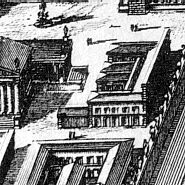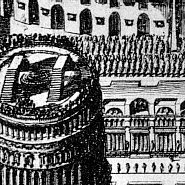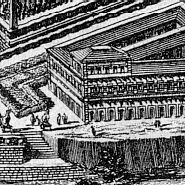| |
2000.04.06
Piranesian daze - otherwise eyes
"Overall, one very Piranesian daze" is the title of the first chapter [actually, all the chapters of [signs of] OTHERWISE EYES begin more or less simultaneously] of Quondam's forthcoming exhibit/book project [signs of] OTHERWISE EYES.
The chapter begins with what the author here believes to be the first documentation of the heretofore undetected two differing published states of Piranesi's Ichnographia Campus Martius, the six fold-out plates that comprise a reenactment plan of ancient Rome within Piranesi's larger Campo Marzio 'archaeological' publication. After many years of redrawing and analyzing a printed reproduction of the Ichnographia, one day in May, 1999 I went to see an original version of the Ichnographia at the University of Pennsylvania's Fine Arts Library. Within minutes of having a 'real' Ichnographia unfolded in front of me, I noticed that the Circus of Caligula and Nero is not only labeled, but also configured somewhat differently than the circus plan I was used to seeing. Of course, I was instantly very excited because nowhere have I ever read about the Ichnographia having two editions/states (like Piranesi's Carceri/Prisons have two published states/editions), and these two different plans are definitely not noted within Wilton-Ely's recent Giovanni Battista Piranesi - The Complete Etchings. Moreover, I believe I discovered something that no other architect, architectural historian, or art historian had noticed before. I then quickly scanned the rest of the plan to see if any other differences existed, and, sure enough, the Circus Agonalis at Penn is likewise different than the plan commonly reproduced. On 4 April 2000, I finally returned to Penn's Fine Arts Library to document the two different Ichnographia via tracings and taking digital images:

The image above left is the Circus of Caligula and Nero as the Ichnographia is commonly reproduced. The image above right is the Circus of Caligula and Nero as it appears within the University of Pennsylvania's (original) copy of the Campo Marzio.

The image above left is the Circus Agonalia as the Ichnographia is commonly reproduced. The image above right is the Circus Agonalia as it appears within the University of Pennsylvania's (original) copy of the Campo Marzio.
These differing plans raise several questions:
Did Piranesi himself make these changes, or did perhaps his son Francesco, and if Piranesi made them, then why?
Which set of plans were 'drawn' first?
Does this 'change of plan' carry any possible semiotic or symbolic message regarding the Ichnographia's larger meaning?
Does this physical evidence offer any indication of Piranesi's 'design' method?
Within "Overall, one very Piranesian daze" I plan to address all the above questions, and, furthermore, this investigation will lead to an evaluation (and necessary correction) of all the other interpretations of the Ichnographia Campus Martius that have occurred since 1956, most notably the interpretations of Tafuri and his Campo Marzio 'disciples'.
Stephen Lauf
2000.04.09
Piranesian daze, cont.
I've thought of a whole analysis of all the Campo Marzio circuses to go along with the "change of plan," and this analysis, plus the marking of Pagan/Christian inversion will proceed the mistakes texts: "Tafuri's False Prophecies."
| |
2000.04.29

The specific design

that Piranesi put

directly into the

plan with regard

to the prominence

of Mars, I
| |

believe, proves definitively

that Piranesi was

actively reenacting Imperial

Rome as he

came to understand

it. Piranesi assimilated
| |

all the knowledge

about this part

of the city,

and through that

assimilation he ultimately

accomplished a whole

new synthesis.
|